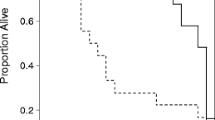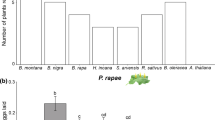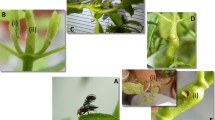Abstract
Alligator weed (Alternanthera philoxeroides (Martius) Grisebach) is an amphibious invasive plant native to South America. It is an allopolyploid that, in Argentina, possess two cytotypes, tetraploids and hexaploids. In the exotic range, the plant is biologically controlled with flea beetle Agasicles hygrophila Selman and Vogt but with different levels of success. The genotype of host plant is an important factor that needs to be considered in biological control programs. We studied how alligator weed ploidy level affects the oviposition preferences of A. hygrophila and its relation with female feeding preference, egg survival and larval performance in its native range. Females recognized the different ploidy levels of alligator weed and preferred to lay eggs on hexaploids than tetraploids. This choice positively affected larval performance and may be explained by the preference–performance hypothesis in this case for different plant cytotypes. Polyploidy should be considered in evaluating and prioritising biological control agents.




Similar content being viewed by others
References
Arvanitis L, Wiklund C, Münzbergova Z, Dahlgren JP, Ehrlén J (2010) Novel antagonistic interactions associated with plant polyploidization influence trait selection and habitat preference. Ecol Lett 13:330–337
Bates D, Maechler M, Bolker B, Walker S (2015) Fitting linear mixed-effects models using lme4. J Stat Softw 67(1):1–48
Boalt E, Arvanitis L, Lethila K, Ehrlén J (2010) The association among herbivory, tolerance, ploidy level, and herbivory pressure in Caramine pratensis. Evol Ecol 24:1101–1113
Bolker BM, Brooks ME, Clark CJ, Geange SW, Poulsen JR, Stevens MHH, White J-SS (2009) Generalized linear mixed models: a practical guide for ecology and evolution. Trends Ecol Evol 24:127–135
Broz A, Manter D, Bowman G, Muller-Scharer H, Vivanco J (2009) Plant origin and ploidy influence gene expression and life cycle characteristics in an invasive weed. BMC Plant Biol 9:33
Bzdega K, Janiak A, Książczyk T, Lewandowska A, Gancarek M, Sliwinska E, Tokarska-Guzik B (2016) A survey of genetic variation and genome evolution within the invasive Fallopia complex. PLoS ONE 11(8):e0161854
Chen Z, Xiong Z, Pan X, Shen S, Geng Y, Xu C, Chen J, Zhang W (2015) Variation of genome size and the ribosomal DNA ITS region of Alternanthera philoxeroides (Amaranthaceae) in Argentina, the USA, and China. J Syt Evol 53:82–87
Gao L, Geng Y, Li B, Chen J, Yang JI (2010) Genome-wide DNA methylation alterations of Alternanthera philoxeroides in natural and manipulated habitats: implications for epigenetic regulation of rapid responses to environmental fluctuation and phenotypic variation. Plant Cell Environ 33:1820–1827
Geng Y, Gao L, Yang J (2013) Epigenetic flexibility underlying phenotypic plasticity. In: Lüttge U, Beyschlag W, Francis D, Cushman J (eds) Progress in botany 74. Springer, Berlin, pp 153–163
Geng Y, van Klinken RD, Sosa A, Li B, Chen J, Xu C-Y (2016) The relative importance of genetic diversity and phenotypic plasticity in determining invasion success of a clonal weed in the USA and China. Front Plant Sci 7:213
Goolsby J, Cortés Mendoza E, Moran P, Adamczyk J, García MÁM, Kirk A (2013) Evaluation of Spanish Arundo scale Rhizaspidiotus donacis (Hemiptera; Diaspididae) survival and fecundity on three new world genotypes of Arundo donax (Poaceae; Arundinoideae). Biocontrol Sci Technol 23:499–506
Guo J-Y, Fu J-W, Xian X-Q, Ma M-Y, Wan F-H (2012) Performance of Agasicles hygrophila (Coleoptera: Chrysomelidae), a biological control agent of invasive alligator weed, at low non-freezing temperatures. Biol Invasions 14:1597–1608
Hufbauer R, Sforza R (2008) Plants database. Multiple introductions of two invasive Centaurea taxa inferred from cpDNA haplotypes. Divers Distrib 14:252–261
Janz N, Thompson JN (2002) Plant polyploidy and host expansion in an insect herbivore. Oecologia 130:570–575
Julien MH, Skarratt B, Maywald GF (1995) Potential geographical distribution of alligator weed and its biological control by Agasicles hygrophila. J Aquat Plant Manage 33:55–60
Julien M, Sosa A, Chan RR, Schooler S, Traversa MG (2012) Alternanthera philoxeroides (Martius) Grisebach-alligatorweed. In: Julien M, McFadyen REC, Cullen JM (eds) Biological control of weeds in Australia. CSIRO Publishing, Collingwood, pp 43–51
Kaplan EL, Meier P (1958) Nonparametric estimation from incomplete observations. J Am Stat Assoc 53:457–481
Keane RM, Crawley MJ (2002) Exotic plant invasions and the enemy release hypothesis. Trends Ecol Evol 17:164–170
Li J, Ye W-H (2006) Genetic diversity of alligator weed ecotypes is not the reason for their different responses to biological control. Aquat Bot 85:155–158
Li N, Li S, Ge J, Schuman MC, Wei JN, Ma RY (2017) Manipulating two olfactory cues causes a biological control beetle to shift to non-target plant species. J Ecol 105:1534–1546
Lu J, Zhao L, Ma R, Zhang P, Fan R, Zhang J (2010) Performance of the biological control agent flea beetle Agasicles hygrophila (Coleoptera: Chrysomelidae), on two plant species Alternanthera philoxeroides (alligatorweed) and A. sessilis (joyweed). Biol Control 54:9–13
Ma R-Y, Jia X-Y, Liu W-Z, Laushman RH, Zhao L-L, Jia D, Wang R (2013) Sequential loss of genetic variation in flea beetle Agasicles hygrophila (Coleoptera: Chrysomelidae) following introduction into China. Insect Sci 20:655–661
Maddox DM (1968) Bionomics of an alligatorweed flea beetle, Agasicles sp.1 in Argentina. Ann Entomol Soc Am 61:1299–1305
Maddox D, Rhyne M (1975) Effects of induced host-plant mineral deficiencies on attraction, feding and fecundity of the alligatorweed flea beetle. Environ Entomol 4:682–686
Manrique V, Cuda J, Overholt W, Williams D, Wheeler G (2008) Effect of host-plant genotypes on the performance of three candidate biological control agents of Schinus terebinthifolius in Florida. Biol Control 47:167–171
Nuismer SL, Thompson JN (2001) Plant polyploidy and non-uniform effects on insect herbivores. Proc Biol Sci 268:1937–1940
Okada KA (1985) Un citotipo hexaploide de Alternanthera philoxeroides como nueva maleza en el partido de Balcarce, provincia de Buenos Aires. Revista de Investigaciones Agropecuarias INTA 20:37–53
Pan X-Y, Jia X, Chen J-K, Li B (2012) For or against: the importance of variation in growth rate for testing the EICA hypothesis. Biol Invasions 14:1–8
Pan XY, Jia X, Fu DJ, Li B (2013) Geographical diversification of growth—defense strategies in an invasive plant. J Syst Evol 51:308–317
Pandit MK, Pocock MJO, Kunin WE (2011) Ploidy influences rarity and invasiveness in plants. J Ecol 99:1108–1115
Paterson ID, Downie DA, Hill MP (2009) Using molecular methods to determine the origin of weed populations of Pereskia aculeata in South Africa and its relevance to biological control. Biol Control 48:84–91
Paterson ID, Hill MP, Downie DA (2012) The effect of host plant intraspecific genetic variation on the fitness of a monophagous biological control agent. Biocontrol Sci Technol 22:513–525
Pöykkö H (2006) Females and larvae of a geometrid moth, Cleorodes lichenaria, prefer a lichen host that assures shortest larval period. Environ Entomol 35:1669–1676
Rasband WS (1997-2005) Image J. U.S. National Institutes of Health
Rausher MD (1983) Ecology of host-selection behavior in phytophagous insects. In: Denno R, McClure M (eds) Variable plants and herbivores in natural and managed systems. Academic Press, New York, pp 223–257
Refsnider JM, Janzen FJ (2010) Putting eggs in one basket: ecological and evolutionary hypotheses for variation in oviposition-site choice. Annu Rev Ecol Evol Syst 41:39–57
Robertson MP, Kriticos DJ, Zachariades C (2008) Climate matching techniques to narrow the search for biological control agents. Biol Control 46:442–452
Saad L, Tiébré MS, Hardy OJ, Mahy G, Vanderhoeven S (2011) Patterns of hybridization and hybrid survival in the invasive Fallopia complex (Polygonaceae). Plant Ecol Evol 144:12–18
Sadeghi H, Gilbert F (1999) Individual variation in oviposition preference, and its interaction with larval performance in an insect predator. Oecologia 118:405–411
Schlaepfer DR, Glättli M, Fischer M, van Kleunen M (2010) A multi-species experiment in their native range indicates pre-adaptation of invasive alien plant species. New Phytol 185:1087–1099
Singer MC (2003) Oviposition preference: its definition, measurement and correlates, and its use in assessing risk of host shifts. In: Cullen JM, Briese DT, Kriticos DJ, Lonsdale WM, Morin L, Scott JK (eds) Proceedings of the 11th international symposium on biological control of weeds. CSIRO Entomology, Canberra, pp 235–244
Singh RJ (2016) Plant cytogenetics. CRC Press, New York
Šingliarová B, Chrtek J, Plačková I, Mráz P (2011) Allozyme variation in diploid, polyploid and mixed-ploidy populations of the Pilosella alpicola group (Asteraceae): relation to morphology, origin of polyploids and breeding system. Folia Geobot 46:387–410
Soltis PS, Soltis DE (2009) The role of hybridization in plant speciation. Annu Rev Plant Biol 60:561–588
Sosa AJ, Greizerstein E, Cardo MV, Telensnicki MC, Julien MH (2008) The evolutionary history of an invasive species: alligator weed, Alternanthera philoxeroides. In: Julien M, Sforza MH, Bon R, Evans HC, Hatcher PE, Hinz HL, Rector BG (eds) Proceedings of the 12th international symposium on biological control of weeds. CABI International Wallingford, pp 435–442
Stewart CA, Chapman RB, Emberson RM, Syrett P, Frampton CMA (1999) The effect of temperature on the development and survival of Agasicles hygrophila Selman & Vogt (Coleoptera: Chrysomelidae), a biological control agent for alligator weed (Alternanthera philoxeroides). N Z J Zool 26:11–20
te Beest M, Le Roux JJ, Richardson DM, Brysting AK, Suda J, Kubešová M, Pyšek P (2011) The more the better? The role of polyploidy in facilitating plant invasions. Ann Bot 109:19–45
R Core Team (2019) R: a language and environment for statistical computing. R Foundation for Statistical Computing, Vienna. https://www.r-project.org/. Development Core Team, Vienna
Telesnicki MC, Sosa AJ, Greizerstein E, Julien MH (2011) Cytogenetic effect of Alternanthera philoxeroides (alligator weed) on Agasicles hygrophila (Coleoptera: Chrysomelidae) in its native range. Biol Control 57:138–142
Thébault A, Gillett F, Müller-Schärer H, Buttler A (2011) Polyploidy and invasion success: trait trade-offs in native and introduced cytotypes of two Asteraceae species. Plant Ecol 212:315–325
Therneau T (2012) A package for survival analysis in S. R package version 2.36-14
Thompson JN, Pellmyr O (1991) Evolution of oviposition behavior and host reference in Lepidoptera. Annu Rev Entomol 36:65–89
Vacek D, East P, Barker J, Soliman M (1985) Feeding and oviposition preferences of Drosophila buzzatii for microbial species isolated from its natural environment. Biol J Linn Soc 24:175–187
Winston RL, Schwarzländer M, Hinz HL, Day MD, Cock MJW, Julien MH (2014) Biological control of weeds: a world catalogue of agents and their target weeds. 5th edn. USDA Forest Service, Forest Health Technology Enterprise Team, Morgantown, FHTET-2014-04
Wise MJ, Partelow JM, Everson KJ, Anselmo MK, Abrahamson WG (2008) Good mothers, bad mothers, and the nature of resistance to herbivory in Solidago altissima. Oecologia 155:257–266
Xu C-Y, Schooler SS, van Klinken RD (2010) Effects of clonal integration and light availability on the growth and physiology of two invasive herbs. J Ecol 98:833–844
Zhang Z, Zhou F, Pan X, van Kleunen M, Liu M, Li B (2019) Evolution of increased intraspecific competitive ability following introduction: the importance of relatedness among genotypes. J Ecol 107:387–395
Zhou B-N, Blaskò G, Cordell GA (1988) Alternanthin, A C-glycosylated flavonoid from Alternanthera philoxeroides. Phytochemistry 27:3633–3636
Acknowledgements
We thank Eduardo Greizerstein (Universidad de Lomas de Zamora) and Florencia Galdeano (Instituto de Botánica del Nordeste) for helping us with ploidy level determination. We also appreciate Guadalupe Traversa, Cristian Battagliotti, Cristina Hernández and Ana Faltlhauser for helping us in the field. We also thank the editors and anonymous reviewers for their comments and suggestions that really improved the original manuscript. This study was financially supported by funds from CONICET (Subsidio extraordinario R.3646/14 and PIP 2014-00331) and Agencia Nacional de Promoción Científica y Tecnológica (PICT 2015-1910).
Author information
Authors and Affiliations
Corresponding author
Ethics declarations
Conflict of interest
The authors have declared that they have no conflict of interest.
Additional information
Handling Editor: S. Raghu.
Rights and permissions
About this article
Cite this article
Krug, P., Sosa, A.J. Mother knows best: plant polyploidy affects feeding and oviposition preference of the alligator weed biological control agent, Agasicles hygrophila. BioControl 64, 623–632 (2019). https://doi.org/10.1007/s10526-019-09959-9
Received:
Accepted:
Published:
Issue Date:
DOI: https://doi.org/10.1007/s10526-019-09959-9




